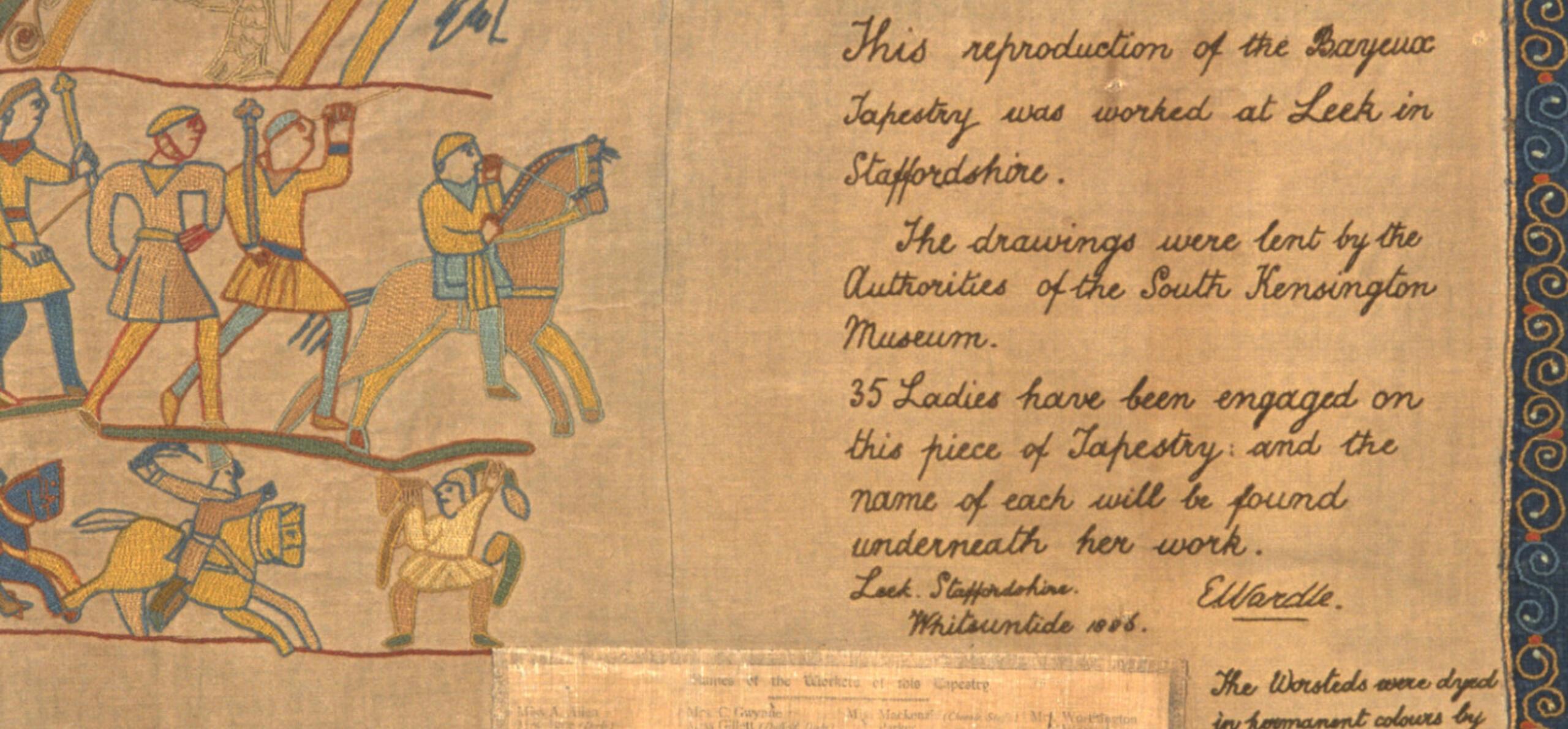The original Bayeux Tapestry
The Bayeux Tapestry is preserved and displayed in Bayeux, in Normandy, France. Nothing is known for certain about the tapestry’s origins. The first written record of the Bayeux Tapestry is in 1476, when it was recorded in the cathedral treasury at Bayeux as 'a very long and narrow hanging on which are embroidered figures and inscriptions comprising a representation of the conquest of England'.
The Bayeux Tapestry was probably commissioned in the 1070s by Bishop Odo of Bayeux, half-brother of William the Conqueror. It is over 70 metres long and although it is called a tapestry it is in fact an embroidery, stitched not woven in woollen yarns on linen. Some historians argue that it was embroidered in Kent, England. The original tapestry is on display at Bayeux in Normandy, France.
The Victorian replica
'England should have a copy of its own'
It was the idea of Elizabeth Wardle to make the replica Bayeux Tapestry, now on display in Reading Museum. She was a skilled embroiderer and a member of the Leek Embroidery Society in Staffordshire. Her husband, Thomas Wardle was a leading silk industrialist. Elizabeth Wardle researched the Bayeux Tapestry by visiting Bayeux in 1885. The Society also based the replica on hand-coloured photographs of the tapestry held by the South Kensington Museum, now called the Victoria & Albert Museum, London. The aim of the project was to make a full-sized and accurate replica of the Bayeux Tapestry, 'so that England should have a copy of its own'.
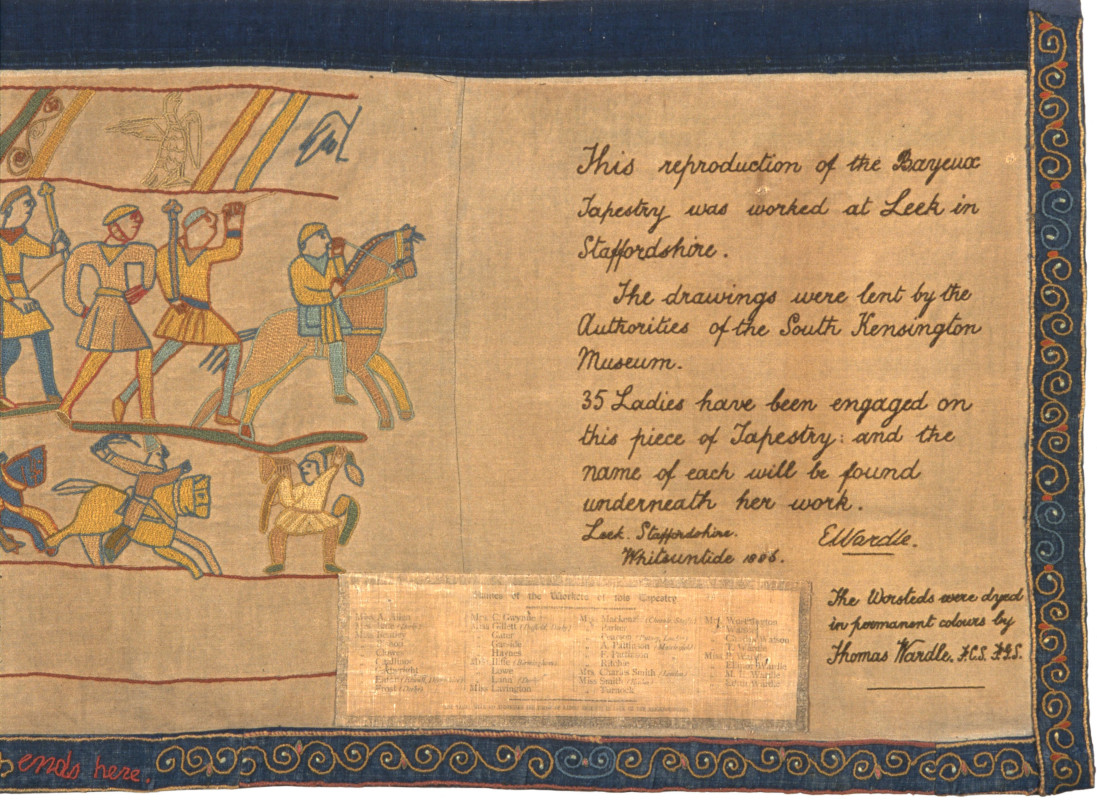
This is the final panel of our tapestry. Here, Elizabeth Wardle refers to the thirty-five women who worked on the reproduction. It was completed on Whitsuntide 1886.
This ambitious project was completed in just over a year. As well as members from Leek, women from Derbyshire, Birmingham, Macclesfield and London took part. Each embroiderer stitched her name beneath her completed panel. Elizabeth Wardle added the final inscription at the end of the tapestry in Whitsuntide 1886.
The women who created Reading's copy were:
Miss Alice Allen
Miss Emily A. Bate
Miss Emma Bentley (Leek)
Miss Mary Bishop
Miss Ann Cartwright
Miss Mabel Challinor
Miss Ann Clowes
Miss Elizabeth Eaton (Etwall, Derbyshire)
Miss Elizabeth Frost (Derby)
Miss Mary Alice Garside
Miss Patience E. Gater
Miss M.H. Gillett (Duffield, Derby)
Mrs Mary Adeline (Charles) Gwynne
Miss Elizabeth Haynes
Miss Sarah Iliffe (Edgbaston, Birmingham)
Miss Beatrice Lavington
Mrs Anne Mills Lowe
Mrs Elizabeth V. Lunn (Derby)
Miss Lizzie Mackenzie (Cheadle, Staffs)
Miss Emily Parker
Miss Alice Pattinson (Macclesfield)
Miss Florence Pattinson (Macclesfield)
Miss Florence M. Pearson (Putney, London)
Miss Margaret J. Ritchie
Miss Anne Smith (Endon Bank)
Mrs Jennie (Charles) Smith
Miss Mary E. Turnock
Miss Edith Wardle
Mrs Elizabeth Wardle
Miss Ellinor Wardle
Miss Margaret W. Wardle
Miss Phoebe Wardle (Cheddleton Heath)
Mrs Margaret E. Watson
Mrs Mary Edith Watson
Mrs Margaret Maude Worthington
Lizzie Allen (Mrs Coombe) prepared all the drawings, which were based on coloured drawings lent by the South Kensington Museum. Mrs Clara Bill joined all the sections together.
Spot the difference!
The Society went to great efforts to make the tapestry as accurate as possible - but there are a few uniquely Victorian additions. In the borders there are several naked men but in the Reading copy one man's modesty has been protected with pants! The women of Leek were not responsible for this prudish addition as is often repeated - they had simply copied them from the set of photographs that had been ‘cleaned-up’ by the male staff at the South Kensington Museum. You can find out more about the photography of the Bayeux Tapestry on the V&A website.
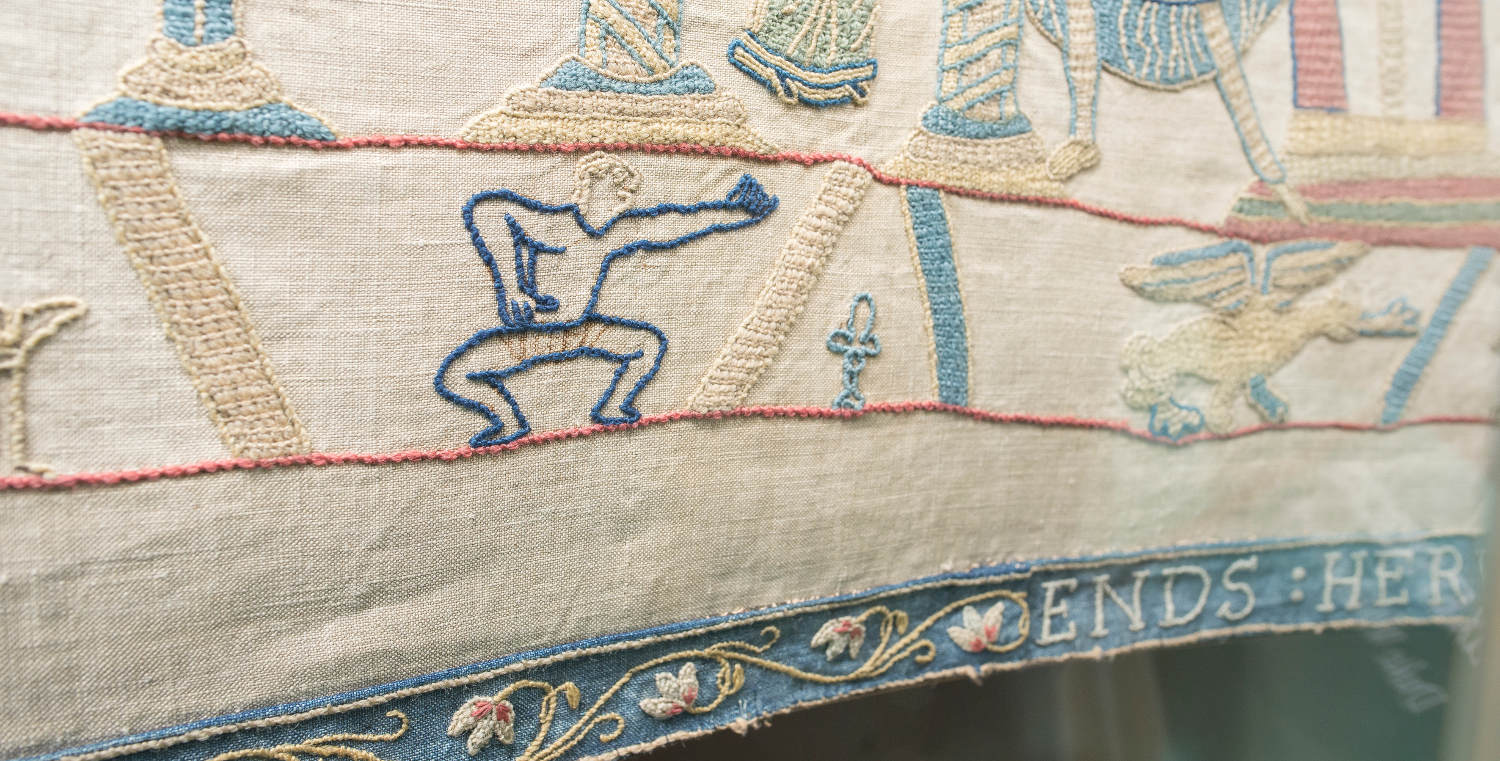
The Victorian women copied underwear that had been added to hand-coloured photographs at the South Kensington Museum
Touring with the replica
The replica Bayeux Tapestry was first exhibited in the Nicholson Institute in Leek in June 1886. Over the next ten years the tapestry was put on display in towns and cities across Britain and it even travelled to Germany and America.
A permanent home in Reading
In 1895 the replica Bayeux Tapestry was exhibited in the Town Hall at Reading. The Reading exhibition was supported by Alderman Arthur Hill, a former Mayor. Hill offered to buy the replica. This offer was accepted by the Leek Embroidery Society. He then presented the tapestry as a gift to Reading where it was displayed in the Reading Museum and Art Gallery. It was a fitting addition to Reading's collections as in 1121 William the Conqueror's youngest son King Henry I had founded Reading Abbey, where he was buried in 1136.
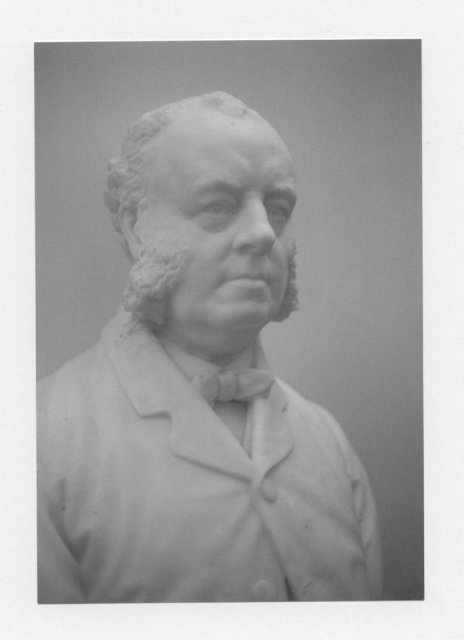
This stone carving of Arthur Hill was produced by sculptor George Blackall Simonds in 1888. Simonds was a sculptor of both national and international significance, creating over two-hundred statues. Museum object number REDMG : 1996.203.1
From 1897 until 1927 the tapestry was displayed high-up around the walls of the Museum's new Art Gallery. In 1927 it was taken down cleaned, repaired and remounted as 25 separate panels and housed in dust-proof cases by Heelas of Reading. It was then sent on tour across Britain and even internationally until the outbreak of the Second World War.
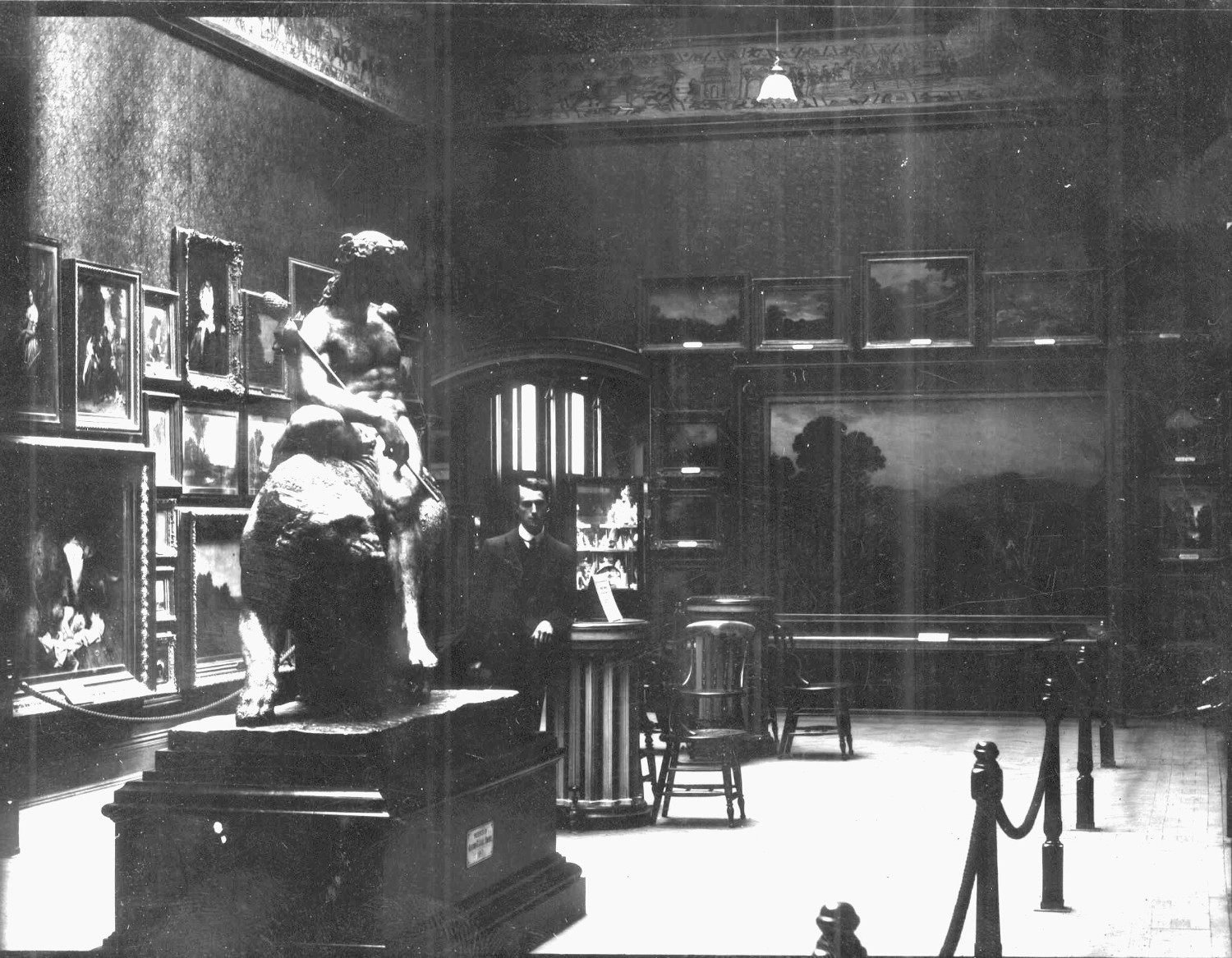
The tapestry displayed high on the walls of the Art Gallery in about 1920 (museum no. 1997.150.321)
The Bayeux Gallery
In 1993, a new Bayeux Tapestry gallery was opened in the Museum. The tapestry was carefully conserved and remounted as a continuous strip in a specially designed display case. For the first time for many years the entire tapestry could be seen in one gallery.
Today, you can visit the Bayeux Tapestry gallery and see for yourself the work of the skilled Victorian women of Leek as well as discovering the story of the Norman Conquest.
